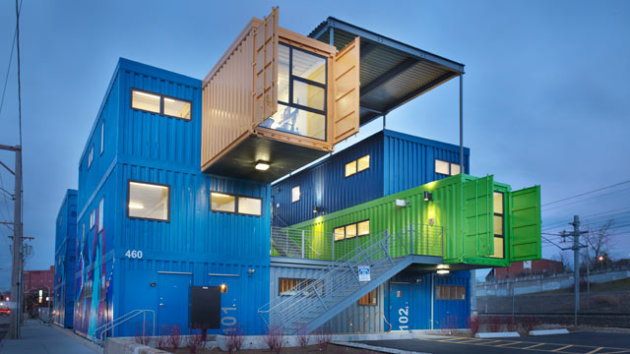В продолжение новости Американская мечта-2012: Домик для Пана Тыквы (http://aftershock.su/?q=node/18868)- в США начинают строить дома из контейнеров для перевозки морских грузов. В ответ на коллапс физической экономики, сокращение морских перевозок и ржавеющие остова старых контейнеров, "невидимая рука рынка" решила, что пришло время строить дома из грузовых контейнеров:

ИСТОЧНИК http://news.yahoo.com/shipping-containers-become-condos-detroit-110032447--abc-news-topstories.html
Гы. Ждем дома, сооруженные из использованных айфонов и хвороста. Ну а через пару поколений - в пещерах, где будет жить "средний класс", который в силах себе позволить ипотечные выплаты за пещеру :-).
Shipping Containers to Become Condos in Detroit
The first U.S. multi-family condo built of used shipping containers is slated to break ground in Detroit early next year.
Strong, durable and portable, shipping containers stack easily and link together like Legos. About 25 million of these 20-by-40 feet multicolored boxes move through U.S. container ports a year, hauling children's toys, flat-screen TVs, computers, car parts, sneakers and sweaters.
But so much travel takes its toll, and eventually the containers wear out and are retired. That's when architects and designers, especially those with a "green" bent, step in to turn these cast-off boxes into student housing in Amsterdam, artists' studios, emergency shelters, health clinics, office buildings.
Despite an oft-reported glut of unused cargo containers lying idle around U.S. ports and ship yards - estimates have ranged from 700,000 to 2 million - the Intermodal Steel Building Units and Container Homes Association puts the number closer to 12,000, including what's sold on Craigslist and eBay.
Joel Egan, co-founder of HyBrid Architecture in Seattle, which has built cottages and office buildings from shipping containers for close to a decade and coined the term " cargotecture" to describe this method of construction, warns that although containers can be bought for as little as $2,500, they shouldn't be seen as a low-cost housing solution.
"Ninety-five percent of the cost still remains," he says.
Here's a few recent North American projects - including the new condo complex - where the shipping container takes center stage:
Exceptional Green Living on Rosa Parks, Detroit: Container to Condo
This 20-unit, four-story condo complex consisting of 93 stacked cargo containers - the first U.S. multi-family residence to be built from these discarded vessels - has been in the works for four years. Tabled when the national real estate market shattered, the project is now scheduled to break ground early next year in midtown Detroit. The units will come rigged with ductless heating and air systems, tankless water heaters and other energy-saving systems. "We're putting money into these energy efficiencies so that the tenant has reduced energy costs," says Leslie Horn, CEO of Three Squared, the project's developer. "And we can build in less than half the time."
The Sunset Cargotecture House, Seattle: Home Sweet Container
Image Credit: Photo by Thomas J. Story, Sunset Publishing Corp.
Built and designed by HyBrid Architecture as the Sunset magazine Idea House 2011, this 192-square-foot solar-powered backyard container cottage is not even half the size of a New York City studio apartment.
Still, it manages to pack in a galley kitchen and micro bathroom with a ceiling-mounted showerhead - the floor's redwood slats hide a drain - and can sleep up to four (a bed unfolds from the wall, a couch converts, another bed can be added). But given the close quarters, it's probably best if everyone's related.
Cinco Camp, Brewster County, Texas: Light on the Land
Image Credit: Hester + Hardaway
Five freestanding cargo containers lined up and cinched together on a 3,000-acre ranch in the rugged, rocky high desert mountains of West Texas reduce life to its basics: One container holds a living room; two house bedrooms and bathrooms; another a kitchen and eating area, while the last is for storage.
Minimalism was the goal here. "It was more about the arrangement of the boxes. Most architects see those containers, and they want to manipulate them too much and cut them all up," says Mark Wellen, who designed Cinco Camp for Roger Black, a former Rolling Stone and New York Times art director who'd grown sick of the Hamptons.
Stripped of their paint and topped with large roof canopies for shade, each box sits off the ground on short stilts. "There's rattlesnakes, scorpions, spiders, all kinds of bugs," says Wellen. "We made a conscious effort to get it off the ground."
Weirdly enough, a major east-west railroad runs through this middle-of-nowhere terrain three to five times a day, its long, distant cars loaded with shipping containers, a regular reminder from where this home came.
The Box Office, Providence, R.I.: Lego Land
Image Credit: Nat Rea
Rust-tinted brown wasn't the look the Box Office designers were going for. This three-story, 12,000-square-foot complex, which sits like a child's Lego dome in a post-industrial section of Providence, is the largest office building in the United States made exclusively of cargo containers.
"The building is made of 140 tons of recycled steel, but it's very difficult for a green building to have an identity," says Peter Case, who developed and helped design the Box Office. "The bright paint, the solar panels on top get the message across that this is a green building."
Case abandoned plans for a conventional office complex when the economy faltered and instead bought 35 shipping containers. But, he says, with construction costs at $1.6 million, the containers didn't really save him money.
"A shipping container doesn't want to be a building," Case explains. "So you have to do quite a bit of gymnastics that cost money." But the Box Office is four times more energy efficient than a typical office building, and that's where Case says he'll see savings. "There's no way for air to come in or out of a shipping container," he says, "unless you want it to."
Muvbox, Montreal: Take a Break in a Crate
Image Credit: Courtesy of Muvbox
An art object by night and a snack cart by day, this pop-up lobster shack opened in the Old Port of Montreal two years ago. Motorized and illuminated by solar-powered batteries, Muvbox opens and closes in about 90 seconds - the side panels unfold to become terraces with table-seating.
The brainchild of Daniel Noiseaux, the design-obsessed restaurateur who brought wood-oven pizza to Montreal 31 years ago, Muvbox was inspired by the horse-drawn snack carts and old-style canteens of centuries past, and Adam Kalkin's Push Button House installation of 2006.
While Montreal was first, Muvboxes have since surfaced in Paris, Toronto and New York's Times Square, where the lobster frescoes yield to black-and-white stripes, and the menu changes from lobster to hot dogs and bagels. A movable feast indeed.
DeKalb Market, Brooklyn, N.Y.: A Portable Souk
Image Credit: Eddy Valante
A cluster of about 60 food and Etsy-style arts and clothing vendors operating out of shipping containers on a vacant Brooklyn lot, the DeKalb Market is no Dordoy Bazaar in Kyrgyzstan or Seven-Kilometer Market in Ukraine. The first U.S. container project of U.K.-based developer Urban Space - most famous for its Container City complexes in London - DeKalb dismantled in October to make way for a long-stalled housing-retail development as its planners continue to negotiate for a new location. Good thing those containers are so portable.
Aprisa Mexican Cuisine, Portland, Ore.: A Movable Taqueria
Image Credit: Courtesy of Kirk Lance
Having had two restaurants fail on him, Kirk Lance vowed if he ever opened another he'd have to be able to pick it up and move it if it started to backslide.
As he drove down the interstate in Oregon, where Lance had moved and had his eco-conscience raised, he noticed "giant yards … with hundreds, possibly thousands" of shipping containers stacked up and suddenly saw his next restaurant. He bought one of these cargo holders, for about $3,000.
"It was the culmination of sustainability and recycling and portability all coming together," Lance says. And then there's the romance of it: "This shipping container has traveled all over the world," says Lance. "It's shipped tons of who knows what, and for me it's kind of intriguing that it gets to have a second life."
Turning the retired cargo vessel into a taqueria wasn't that hard, says Lance. Cutting out windows, spraying in the foam insulation, "anybody with a little construction background can probably figure those things out," he says.
But getting the permits, the blueprints, the structural engineering reports through the state of Oregon took four years, and added "a ton" to the cost, Lance says. "What kept me going was if I could build one of these things and it works well, I could just copy the blueprints and build 100 of them," or pick up and move.
The Shipping Container House, Nederland, Colo.: Still 'Cargotecture'
Image Credit: Braden Gunem
True, the Shipping Container House is not all shipping containers, but by definition it's still cargotecture. The two containers that sandwich the main living area house an office and a bedroom in this 1,500-square-foot mountain home. Designed by Studio H:T in Boulder, Colo., for "a conscientious client who believes in living small and recycling," the solar-powered house can operate entirely off-grid.











